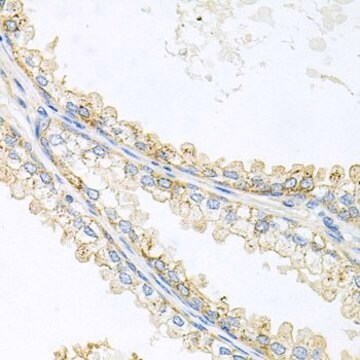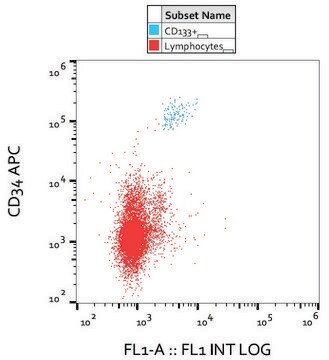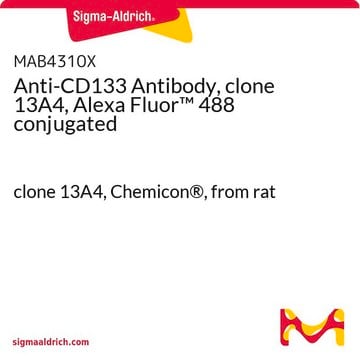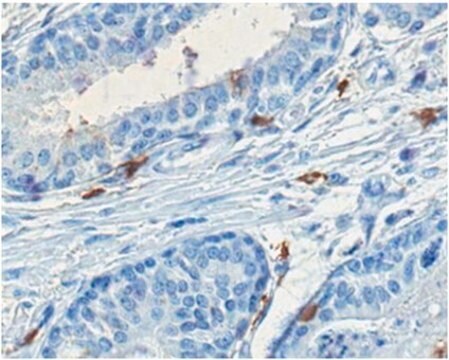MAB4310
Anti-CD133 Antibody, clone 13A4
clone 13A4, Chemicon®, from rat
Synonym(e):
Prominin-1, AC133 (human)
About This Item
Empfohlene Produkte
Biologische Quelle
rat
Qualitätsniveau
Antikörperform
purified immunoglobulin
Antikörper-Produkttyp
primary antibodies
Klon
13A4, monoclonal
Speziesreaktivität
mouse
Darf nicht reagieren mit
chicken, Drosophila, rat
Hersteller/Markenname
Chemicon®
Methode(n)
flow cytometry: suitable
immunohistochemistry: suitable
immunoprecipitation (IP): suitable
western blot: suitable
Aufnahme
sample type hematopoietic stem cell(s)
sample type neural stem cell(s)
sample type epithelial cells
sample type: mouse embryonic stem cell(s)
sample type mesenchymal stem cell(s)
Isotyp
IgG1κ
Eignung
not suitable for immunohistochemistry (Paraffin)
NCBI-Hinterlegungsnummer
UniProt-Hinterlegungsnummer
Versandbedingung
wet ice
Posttranslationale Modifikation Target
unmodified
Angaben zum Gen
dog ... Prom1(488816)
human ... PROM1(8842)
mouse ... Prom1(19126)
rat ... Prom1(60357)
Verwandte Kategorien
Allgemeine Beschreibung
Spezifität
This antibody can be used to isolate murine stem cells from brain and bone marrow.
The 13A4 antibody does not cross react with rat, human, chicken, or Drosophila antigen. The original paper is located at: http://www.pnas.org/cgi/reprint/94/23/12425.pdf
Immunogen
Anwendung
Stammzellforschung
Neurale Stammzellen
Hämatopoetische Stammzellen
Western Blot Analysis: A 1:1000 dilution from a representative lot detected CD133 in monkey kidney lysate.
Zielbeschreibung
Physikalische Form
Lagerung und Haltbarkeit
Hinweis zur Analyse
Positive Control: Kidney tissue or membranes
Negative Control: Liver tissue or membranes
Sonstige Hinweise
Rechtliche Hinweise
Haftungsausschluss
Not finding the right product?
Try our Produkt-Auswahlhilfe.
Lagerklassenschlüssel
10 - Combustible liquids
WGK
WGK 2
Flammpunkt (°F)
Not applicable
Flammpunkt (°C)
Not applicable
Analysenzertifikate (COA)
Suchen Sie nach Analysenzertifikate (COA), indem Sie die Lot-/Chargennummer des Produkts eingeben. Lot- und Chargennummern sind auf dem Produktetikett hinter den Wörtern ‘Lot’ oder ‘Batch’ (Lot oder Charge) zu finden.
Besitzen Sie dieses Produkt bereits?
In der Dokumentenbibliothek finden Sie die Dokumentation zu den Produkten, die Sie kürzlich erworben haben.
Unser Team von Wissenschaftlern verfügt über Erfahrung in allen Forschungsbereichen einschließlich Life Science, Materialwissenschaften, chemischer Synthese, Chromatographie, Analytik und vielen mehr..
Setzen Sie sich mit dem technischen Dienst in Verbindung.








